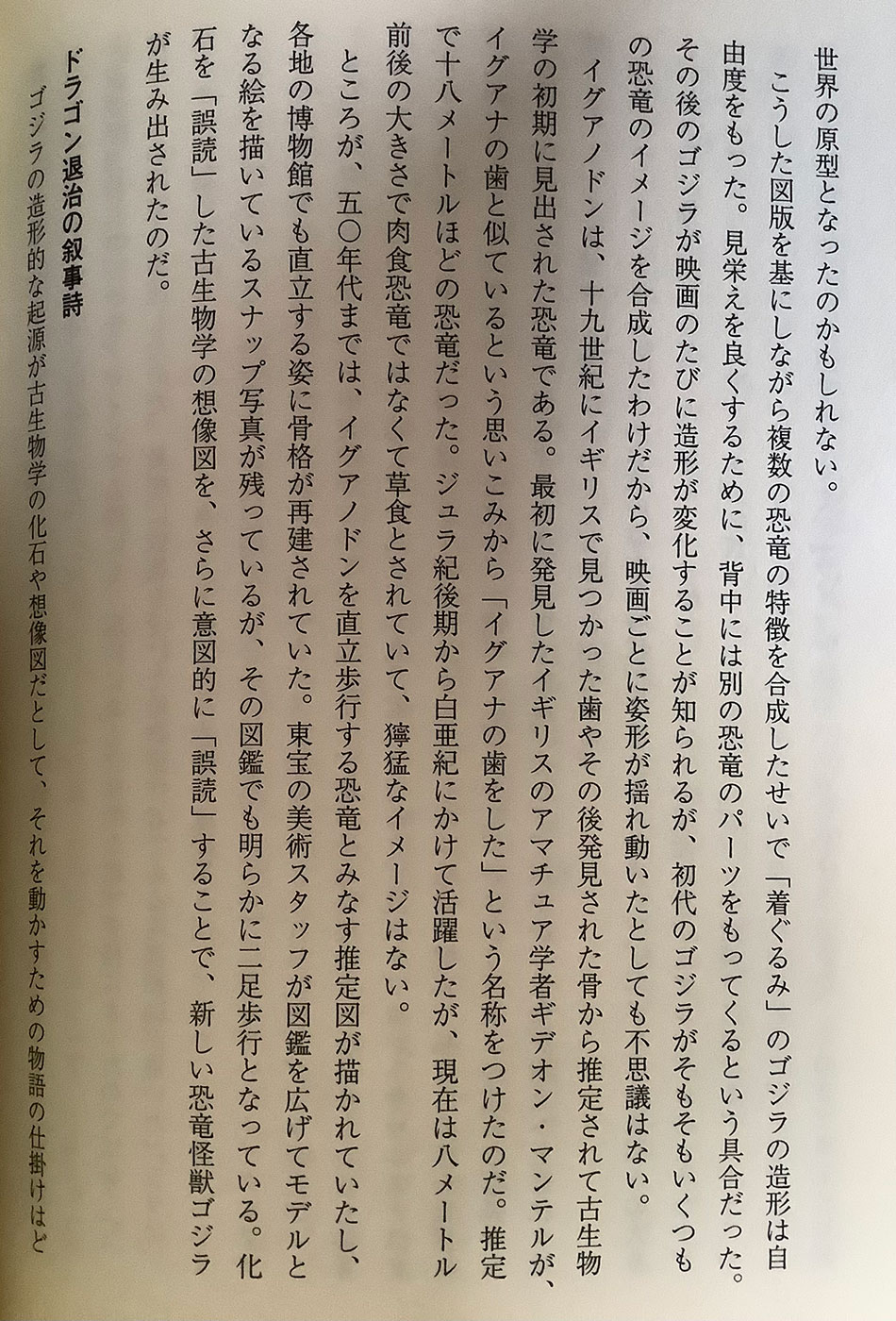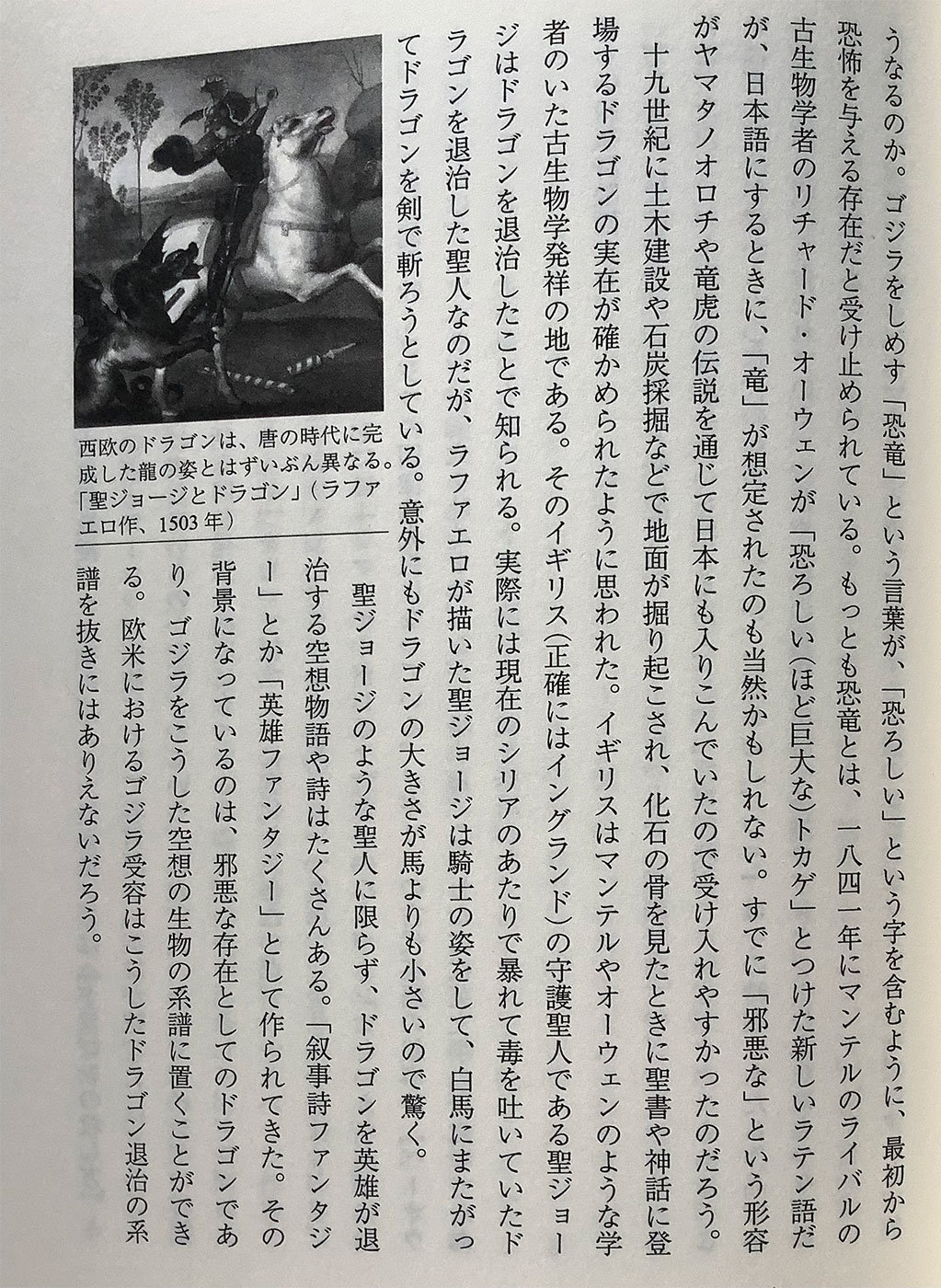10.6.2022
The Cultural History of Godzilla – Pt 14


P 34
問題のティラノサウルスは、「恐竜の偉大な時代」とするセクションで、二ページの見開きの大きなイラストに描きだされている。そして、ティラノサウルスの足元に背中にアルマジロのようなトゲのついた姿をしたアンキロサウルスがいて、これはそのまま『ゴジラの逆襲』におけるアンギラスの造形に流用されたのではないだろうか。もちろん、『ラドン』でおなじみのプテラノドンも空を飛んでいる。恐竜一体ずつの図ではなくて、『ライフ』誌のパノラマのイラストが、そのまま東宝の怪獣世界の原型となったのかもしれない。
The tyrannosaurus in question is depicted in a large two-page spread illustration in the section titled “The Great Age of Dinosaurs.” And at the feet of the Tyrannosaurus, there is an Ankylosaurus that looks like an armadillo with spines on its back. Of course, the familiar pteranodon from “Rodan” is also flying in the sky. It is possible that the panorama illustrations in Life magazine, rather than illustrations of individual dinosaurs, became the prototype for Toho’s world of monsters.
こうした図版を基にしながら複数の恐竜の特徴を合成したせいで「着ぐるみ」のゴジラの造形は自由度をもった。見栄えを良くするために、背中には別の恐竜のパーツをもってくるという具合だった。その後のゴジラが映画のたびに造形が変化することが知られるが、初代のゴジラがそもそもいくつもの恐竜のイメージを合成したわけだから、映画ごとに姿形が揺れ動いたとしても不思議はない。
By synthesizing the characteristics of multiple dinosaurs based on these illustrations, the “costume” Godzilla had a degree of freedom. To make it look nicer, it would have another dinosaur part on its back, and so on. It is known that the form of Godzilla after that changes with each movie, but since the original Godzilla was originally a composite of many images of dinosaurs, it is not surprising that the figure fluctuates with each movie.
イグアノドンは、十九世紀にイギリスで見つかった歯やその後発見された骨から推定されて古生物学の初期に見出された恐竜である。最初に発見したイギリスのアマチュア学者ギデオン・マンテルが、イグアナの歯と似ているという思いこみから「イグアナの歯をした」という名称をつけたのだ。推定で十八メートルほどの恐竜だった。 ジュラ紀後期から白亜紀にかけて活躍したが、現在は八メートル前後の大きさで肉食恐竜ではなくて草食とされていて、獰猛なイメージはない。
Iguanodon is an early paleontological dinosaur, deduced from teeth and later bones found in England in the 19th century. British amateur scientist Gideon Mantell, who first discovered it, gave it the name “iguana tooth,”’ based on his belief that it resembled the tooth of an iguana. It was estimated to be a dinosaur about eighteen meters long. It was active from the late Jurassic period to the Cretaceous period, but currently it is around 8 meters in size and is not a carnivorous dinosaur but a herbivore, so it does not have a ferocious image.
ところが、五〇年代までは、イグアノドンを直立歩行する恐竜とみなす推定図が描かれていたし、各地の博物館でも直立する姿に骨格が再建されていた。東宝の美術スタッフが図鑑を広げてモデルとなる絵を描いているスナップ写真が残っているが、その図鑑でも明らかに二足歩行となっている。化石を「誤読」した古生物学の想像図を、さらに意図的に「誤読」することで、新しい恐竜怪獣ゴジラが生み出されたのだ。
However, until the 1950s, presumed drawings of Iguanodon as a dinosaur walking upright were drawn, and the skeleton was reconstructed in an upright posture in museums around the world. There remains a snapshot of Toho’s art staff drawing a model picture in an encyclopedia, and even in that encyclopedia, it is clearly bipedal. A new dinosaur monster Godzilla was created by intentionally “misreading” the paleontological imaginary map that “misreads” fossils.
ドラゴン退治の叙事詩
Dragon slaying epic

P 35
ゴジラの造形的な起源が古生物学の化石や想像図だとして、それを動かすための物語の仕掛けはどうなるのか。ゴジラをしめす「恐竜」という言葉が、「恐ろしい」という字を含むように、最初から恐怖を与える存在だと受け止められている。もっとも恐竜とは、一八四一年にマンテルのライバルの古生物学者のリチャード・オーウェンが「恐ろしいほど巨大な) トカゲ」とつけた新しいラテン語だが、日本語にするときに、「竜」が想定されたのも当然かもしれない。すでに「邪悪な」という形容がヤマタノオロチや竜虎の伝説を通じて日本にも入りこんでいたので受け入れやすかったのだろう。
If the figurative origin of Godzilla is paleontological fossils and imaginary drawings, what will happen to the narrative mechanism to move it? The word “dinosaur,” which indicates Godzilla, includes the word “terrifying,” and it is perceived as a presence that gives fear from the beginning. Dinosaur is a new Latin word coined in 1841 by Richard Owen, a paleontologist and rival of Mantell’s, to mean “a terrifyingly gigantic lizard.” It may be natural. The epithet “evil” had already entered Japan through the legends of Yamata no Orochi and Dragon and Tiger, so it was probably easy to accept.
十九世紀に土木建設や石炭採掘などで地面が掘り起こされ、化石の骨を見たときに聖書や神話に登場するドラゴンの実在が確かめられたように思われた。イギリスはマンテルやオーウェンのような学者のいた古生物学発祥の地である。そのイギリス(正確にはイングランド)の守護聖人である聖ジョージはドラゴンを退治したことで知られる。実際には現在のシリアのあたりで暴れて毒を吐いていたドラゴンを退治した聖人なのだが、ラファエロが描いた聖ジョージは騎士の姿をして、白馬にまたがっドラゴンを剣で斬ろうとしている。意外にもドラゴンの大きさが馬よりも小さいので驚く。
In the 19th century, the ground was dug up by civil engineering construction and coal mining, and it seemed that the existence of the dragon that appeared in the Bible and myths was confirmed when the fossil bones were seen. England is the cradle of paleontology with scholars such as Mantell and Owen. Saint George, the patron saint of England (or England to be exact), is known for slaying dragons. In fact, he is a saint who exterminated a dragon that was raging and spewing poison around present-day Syria, but St. George depicted by Raphael is in the form of a knight, riding a white horse and trying to slash a dragon with a sword. Surprisingly, the size of the dragon is smaller than the horse.
聖ジョージのような聖人に限らず、ドラゴンを英雄が退治する空想物語や詩はたくさんある。「叙事詩ファンタジー」とか「英雄ファンタジー」として作られてきた。その背景になっているのは、邪悪な存在としてのドラゴンであり、ゴジラをこうした空想の生物の系譜に置くことができる。欧米におけるゴジラ受容はこうしたドラゴン退治の系譜を抜きにはありえないだろう。
There are many fantasies and poems about heroes slaying dragons, not just saints like St. George. It has been made as “epic fantasy” or “heroic fantasy.” Its background is the dragon as an evil entity, and Godzilla can be placed in the lineage of these fantasy creatures. Godzilla acceptance in Europe and the United States would not be possible without such a lineage of dragon extermination.
Caption
西欧のドラゴンは、唐の時代に完成した龍の姿とはずいぶん異なる。「聖ジョージとドラゴン」 (ラファエロ作、1503年)
Western European dragons are very different from the dragons perfected in the Tang Dynasty. “St. George and the Dragon” (Raphael, 1503)